MARIANI’SVirtual
Gourmet
July
6, 2014
NEWSLETTER
HOME
| BOOKS
| ABOUT US
| CONTACT

HAVE A GREAT FOURTH OF JULY WEEKEND!
❖❖❖
IN THIS ISSUE
DINING OUT IN NEW ORLEANS, Part One
By John Mariani
NEW YORK CORNER
The Sea Grill
By John Mariani
NOTES FROM THE WINE CELLAR
WINES I'M DRINKING THIS SUMMER
By John Mariani
❖❖❖
DINING OUT IN NEW ORLEANS, Part One
By John Mariani

NEW ORLEANS, Part One
By John Mariani
The smallest of excuses to throw a party can send New Orleanians into the streets, but a big excuse, like the 2014 New Orleans Wine & Food Experience held this May, filled the streets and seminar halls, bars and restaurants for four full days of revelry.
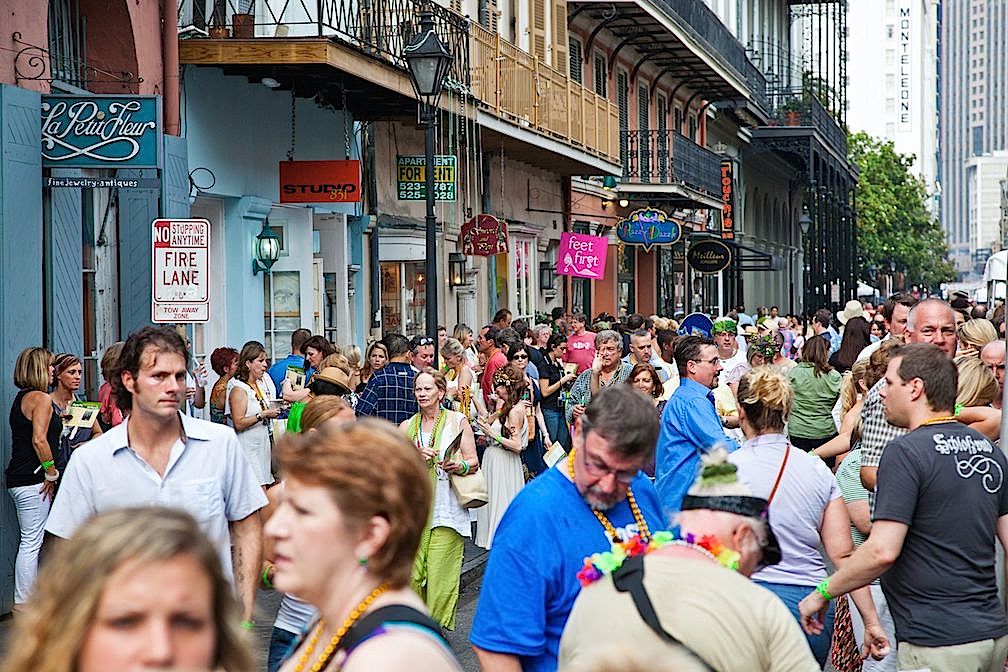 There were wine tastings,
with names like “I Get a Kick from Crémant ,” “Fresh
and Dried” (for which I
was a panelist), and “Talk Dirty to Me,” which was
about soil and
terroir. But the biggest event was the Royal
Street Stroll, which began at the Hotel
Monteleone’s
Carousel Bar, then wound its way for about eight blocks
through the French Quarter, the street lined with
winery personnel
pouring their products and restaurateurs dishing out
their food.
If you actually made it all the way down the line
and tasted everything,
you probably wouldn’t be up for dinner. Unless
you are a true New Orleanian, who is always up for dinner.
There were wine tastings,
with names like “I Get a Kick from Crémant ,” “Fresh
and Dried” (for which I
was a panelist), and “Talk Dirty to Me,” which was
about soil and
terroir. But the biggest event was the Royal
Street Stroll, which began at the Hotel
Monteleone’s
Carousel Bar, then wound its way for about eight blocks
through the French Quarter, the street lined with
winery personnel
pouring their products and restaurateurs dishing out
their food.
If you actually made it all the way down the line
and tasted everything,
you probably wouldn’t be up for dinner. Unless
you are a true New Orleanian, who is always up for dinner.
As a guest of NOWFE, I was checked into an amazing penthouse suite at the Monteleone, formerly the hotel owner’s own apartment, with a grand view of the Mississippi and all that sails along its broad banks. The hotel itself has undergone a worthwhile renovation that shows from the lobby to the perpetually packed Carousel Bar to rooms that balance old motifs and furnishings with every modern amenity.
Of course, I was also on a hunt for new restaurants while going back to those I love and doing the obligatory visit to the Café du Monde to join a thousand others munching hot sugared beignets with chicory cafe au lait (right). Finding a table at any hour is not easy (try the side room), but you can take out a bag of beignets and go sit by the river and munch away. I’ve never been able to figure out why the majority of the Café’s staff seems to be Vietnamese, but they are speedy and apparently able to work through even the hottest, most humid days visited upon New Orleans
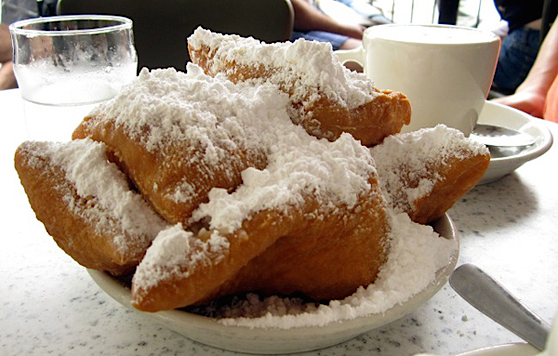 in summer.
in summer.
I also went for my obligatory lunch at Galatoire’s, which, as I wrote last year, had a true renaissance as of 2009, when a new investor group took over the 109-year-old restaurant and revamped everything inside, from the kitchen and once fusty upstairs to the reclaiming of the fleur de lys-dotted wall coverings.
New chef Michael Sichel has maintained all the old Creole traditions while refining every dish on the long menu, more dependent than ever on the freshest ingredients in the market. Some of the old--and I mean very old--waiters are still serving generations of families who come here, but there are young ones too to ensure Galatoire’s changes while remaining very much the same.
Until Galatoire’s started taking reservations a few years ago for the now handsome upstairs dining room, a well-behaved line of people would stretch down the block to the corner of Iberville Street for lunch to wait for a table downstairs, which is to Galatoire’s what the Sistine Chapel is to the Vatican. Even in the sauna-like heat of summer, the women dress to the nines in pastels and men wear seersucker suits, bow ties, and the white Panama hats they bought at Meyer the Hatter on Saint Charles Avenue.
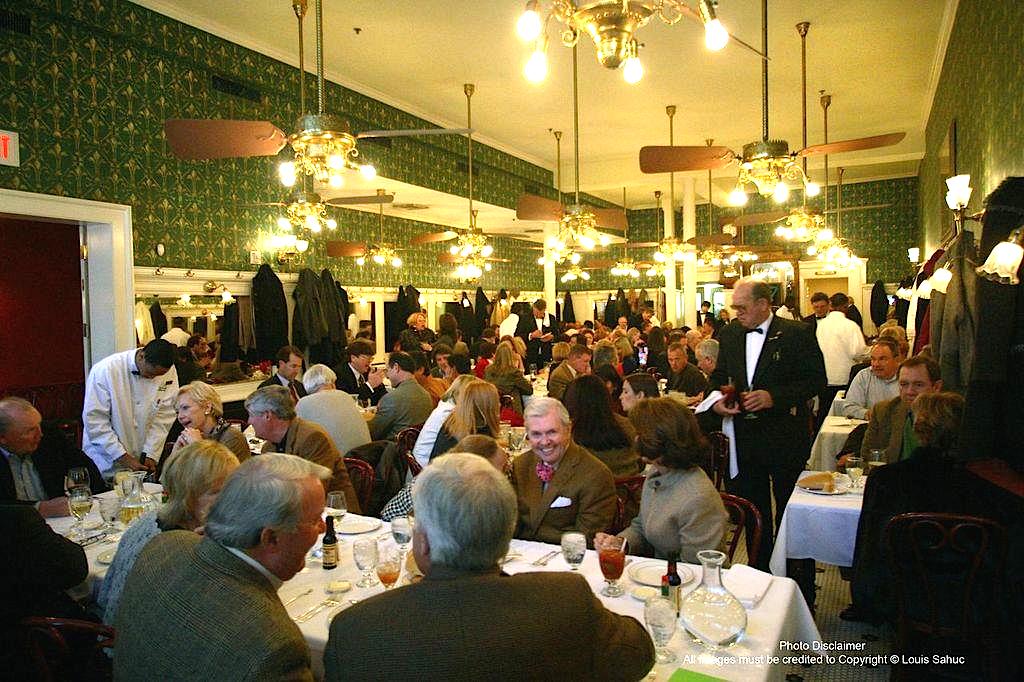 The waiter
reels off the day’s specials, the busboy brings ice
water and a glass
pitcher, and a table for two still gets eight pats
of butter and
a loaf of hot bread, refreshed after a while even if
not used. You peruse the menu, which, by and large, has
not changed in decades and has never strayed from its
Creole traditions of classics like gumbo, shrimp
remoulade, oysters
Rockefeller, and chicken Bonne-Femme.
The waiter
reels off the day’s specials, the busboy brings ice
water and a glass
pitcher, and a table for two still gets eight pats
of butter and
a loaf of hot bread, refreshed after a while even if
not used. You peruse the menu, which, by and large, has
not changed in decades and has never strayed from its
Creole traditions of classics like gumbo, shrimp
remoulade, oysters
Rockefeller, and chicken Bonne-Femme. By one o’clock things are in full swing, and voices rise with laughter as everyone digs into lunch--thick, ruddy red turtle soup, a gumbo rich with duck and andouille, trout mounted high with lump crabmeat and almonds, and pompano--the fish Mark Twain said was as “delicious as the less criminal forms of sin.” The fish here begin their day in the Gulf and end up swimming in lakes of good butter. The lyonnaise potatoes come hidden under a thatch of sweet onions.
A bottle of Chassagne-Montrachet from an excellent wine list turns in its ice bucket and dishes arrive at a civilized pace.
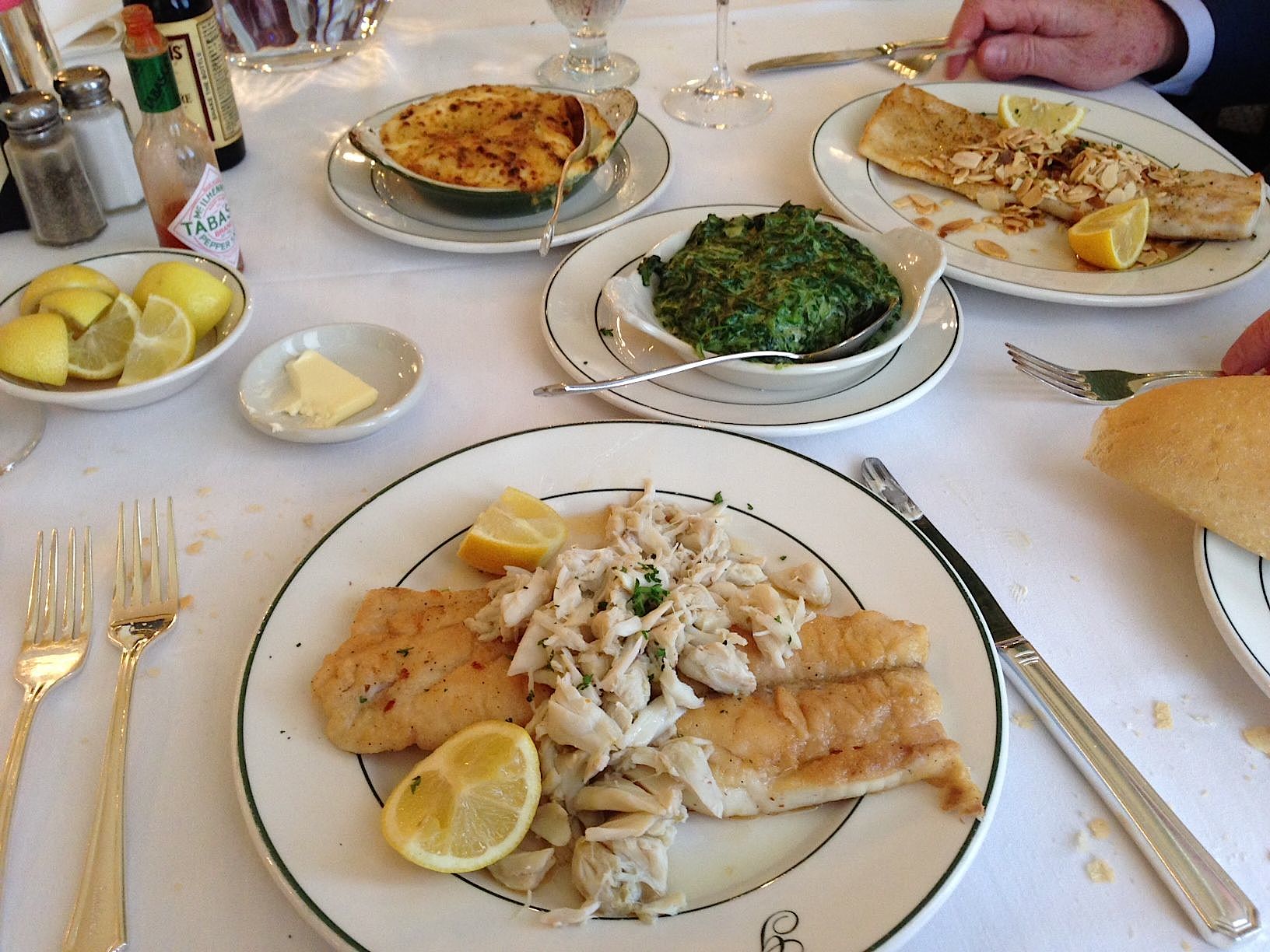 On my
recent visit
I began with soft-shell crabs--not yet very large
back in May—crisp and mahogany colored, sautéed gently
with butter. Sweetbreads were plump and silky, black drum rich
with butter and crabmeat galore. The fried
onions rings, the au
gratin potatoes, and the creamed spinach are all
signature items here
for good reason. A best bet is to go for the
“Galatoire’s
Gouté,” a taste of various seafood as
appetizers.
On my
recent visit
I began with soft-shell crabs--not yet very large
back in May—crisp and mahogany colored, sautéed gently
with butter. Sweetbreads were plump and silky, black drum rich
with butter and crabmeat galore. The fried
onions rings, the au
gratin potatoes, and the creamed spinach are all
signature items here
for good reason. A best bet is to go for the
“Galatoire’s
Gouté,” a taste of various seafood as
appetizers. (I usually don't order meat at Galatoire’s, not because it is not equal to the seafood but only because the seafood is so irresistible. For meat I go right next door to the year-old Galatoire’s 33 Bar & Steak, which I think serves the best beef in the city.)
For dessert I always go for the bread pudding, a luxuriant and very rich thing to consider after a big lunch here, but then I don't make plans
very far ahead when I eat at Galatoire’s.
Galatoire’s is open for lunch and dinner. Appetizers run $7-$14, entrees
$19-$42.
 I
also returned to a place I have not much frequented
in the past several
years--K-Paul’s
Louisiana Kitchen, which, when it opened back
in 1979
caused such a gastronomic stir that its famous
blackened redfish--heretofore
not a species many cared for--was nearly wiped out
commercially, and there
was a federal ban on the catch for years.
I
also returned to a place I have not much frequented
in the past several
years--K-Paul’s
Louisiana Kitchen, which, when it opened back
in 1979
caused such a gastronomic stir that its famous
blackened redfish--heretofore
not a species many cared for--was nearly wiped out
commercially, and there
was a federal ban on the catch for years. K-Paul’s was something New Orleans had little to compare to, for it was decidedly Cajun, as interpreted by chef Paul Prudhomme, not Creole, and he went on to become one of the first celebrity chefs, long before Emeril Lagasse (who’d taken his chef’s position when Prudhomme left Commander’s Palace). The cooking was astonishingly rich in butter and peppery seasonings, and the rave reviews nationally had the effect of showing that Americans do not all like to eat bland food. One taste of Prudhomme’s Cajun jambalaya or his duck and shrimp Dulac would make a convert of everyone else.
In the ensuing years Prudhomme decreased his presence in his restaurant, writing cookbooks, doing TV cooking shows, bottling his spice mix Cajun Magic through the McCormick company, and losing a tremendous amount of weight. His star didn't so much lose its luster as it did its visibility, and when I asked last month about Paul’s whereabouts, several locals, including chefs, said they hadn’t really heard much about him or seen him in two or three years.
Sadly, on the basis of a visit to K-Paul’s at lunchtime, open Thursday through Saturday, which now serves a diner menu, I’d urge Prudhomme to spend a lot
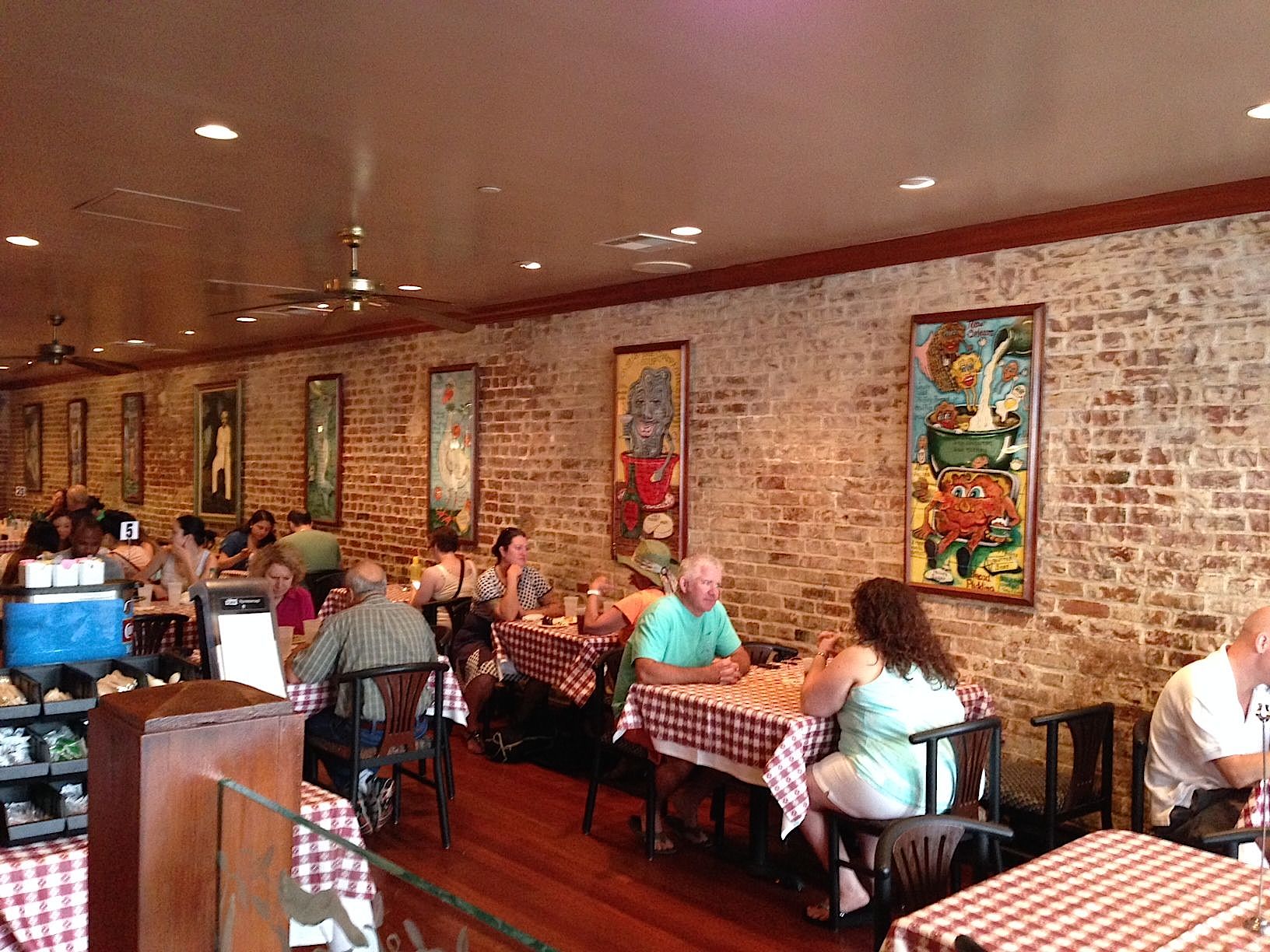 more time in his
restaurant. Where once the place looked like a
funky hole-in-the-wall,
it now looks like a thousand other casual eateries,
like Applebee’s or TGI
Friday's. You are greeted briskly and told to line
up and place your order and get a number. And then you wait,
which can be 20 minutes just to get a bowl of soup or some
rolls, which, by the way, have little of the
rich, buttery, yeasty
flavor they used to.
more time in his
restaurant. Where once the place looked like a
funky hole-in-the-wall,
it now looks like a thousand other casual eateries,
like Applebee’s or TGI
Friday's. You are greeted briskly and told to line
up and place your order and get a number. And then you wait,
which can be 20 minutes just to get a bowl of soup or some
rolls, which, by the way, have little of the
rich, buttery, yeasty
flavor they used to. A chicken and andouille gumbo lacked anything to make it distinctive in a city full of good gumbos, the fried pork cutlet with a bourbon glaze was just a mess of gumminess, and the sweet potato fries were limp. I saw know reason to continue on with dessert.
The whole experience lacked the “How y’all doin’?” ambiance K-Paul’s once had, especially when K, Paul’s late wife, was around. In the kitchen a lifeless staff now goes through the motions.
I’d like to think that at dinnertime, K-Paul’s retains what once made it a very significant bellwether restaurant; the menu shows that a lot of the
old dishes are still there. So I withhold my judgment of K-Paul’s, except to say that the great man’s presence is definitely needed for what has always been one of the most highly personalized restaurants in the French Quarter.
K-Paul’s is open for dinner Mon.-Sat.; appetizers start at $6.95, main
courses at $29.95.
By Andrew Chalk
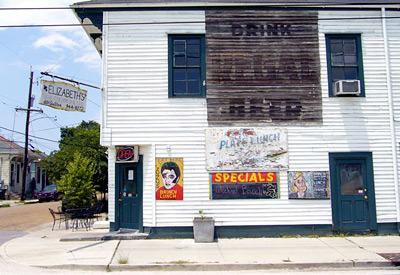 New Orleans is a capsule
of a different culture implanted right in
the heart of
America, one that exalts its fine food and good
times.
New Orleans is a capsule
of a different culture implanted right in
the heart of
America, one that exalts its fine food and good
times. When I visited on a St. Patrick’s Day weekend, I found the town full to the rafters and as ready as ever to party, so I took the opportunity to search out some joints far off the radar.
Some local friends proclaimed Elizabeth's the "best breakfast/lunch in the city," so we headed into Bywater, a healthy 30-minute walk or ten-minute pedicab ride from Jackson Square. As locals have it, you enter Bywater from the west when you cross the tracks at Press Street. Perched on the corner of Gallier Street and Chartres Street, Elizabeth's in an old two-story building built in what might be described as New Orleans ramshackle-style of architecture. Inside are closely spaced tables surrounded by eclectic New Orleans memorabilia-clad walls with a chalkboard of specials to one side. Stairs on one end of the back wall head up to additional seating. You won't see this establishment on the cover of Architectural Digest, but you will like its immediate, unpretentious appeal.
The front door is manned by several of those outgoing “girl-next-door with a liberal arts degree who joined the counterculture” types who ingratiate you with consummate ease. Once seated, I regarded the eclectic clientele, which seemed overwhelmingly to be locals--artists, musicians, hipsters with a fair amount of tattoo work and non-TSA-approved face metal. More recently, young professionals have moved to the area, owing to its proximity to the center of the city, so property prices have doubled since Hurricane Katrina.
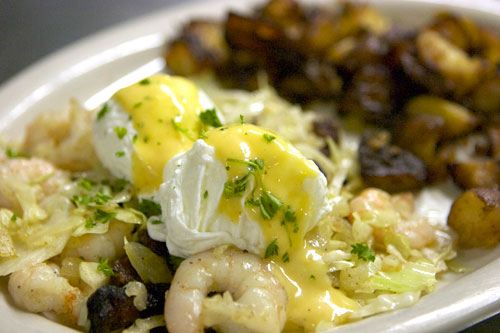
A menu scan revealed the most Creole-centric lineup that we had come across thus far. I breathed a sigh of relief, after enduring a string of faux Creole tourist traps in the French Quarter. Here, stuffed mirliton ($8) is stuffed with finely diced shrimp and topped with breadcrumbs, all adorned with a béchamel sauce with flecks of finely diced scallions. The mouth feel is a homey combination of the softly fibrous mirliton, the crisp breadcrumbs, earthy seafood and the creamy sweetness of onions in the béchamel. Bywater, incidentally, has an annual Mirliton Street Festival each November, which, like all New Orleans festivals, features music and drinking.
Service has been highly praised at Elizabeth’s, but on the occasion of our visit it was inordinately sluggish. The reason is that our waitress seemed to be the slowest moving thing since the subsiding of the Hurricane Katrina flood waters. Other servers seem to get twice as much done in the same time.
We ordered an appetizer of fried chicken livers with Elizabeth’s pepper jelly ($8). Lots of lasting earthy liver taste in the mouth and the pepper jelly is a good idea here. It provides the moisture the dish needs to offset the fairly thick dry batter. The helping is massive. Add to that the fact that livers in crisp, hard batter are filling and you have enough food in this appetizer for two adults. For most diners, this dish will find most of itself bagged for breakfast tomorrow.
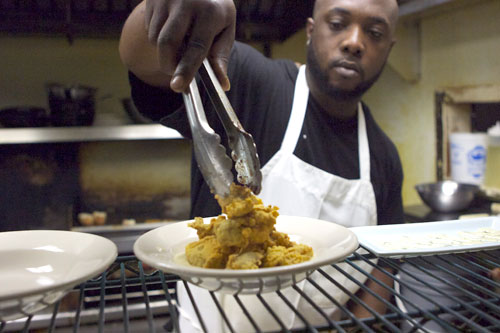 On to
entreés. We tried Cajun Bubble and Squeak
($16.50, above).
It has been
said that anything left over can go into bubble and
squeak (named after
the noise it makes while shallow-frying), so
Elizabeth’s has no qualms about using chopped country bacon and
shrimp to accompany the cabbage staple. The ham is
deliciously tender, in contrast to the shoe leather-tough slice I had
at The Court of Two Sisters the day before.
On to
entreés. We tried Cajun Bubble and Squeak
($16.50, above).
It has been
said that anything left over can go into bubble and
squeak (named after
the noise it makes while shallow-frying), so
Elizabeth’s has no qualms about using chopped country bacon and
shrimp to accompany the cabbage staple. The ham is
deliciously tender, in contrast to the shoe leather-tough slice I had
at The Court of Two Sisters the day before.Shrimp and all is topped with poached eggs and hollandaise. Hollandaise sauce is a useful culinary tripwire. It is so easy to get wrong, or just to render in a mediocre fashion. Is it bright, smooth and homemade? Or is it eked, mass produced, from a gloop jar? Do the egg yolks glow with beta-carotene rich yellow? Elizabeth’s passed muster on these points.
We hit the blackboard for our final dish: pan seared red drum topped with eggs and hollandaise. Egg with fish may be an acquired taste, but Elizabeth’s makes it easy to acquire.
There are traditional breakfasts on the menu as well. For example, Basic Breakfast ($7.50) is two eggs any style, with hash browns or grits and toast or biscuit. And, since this is New Orleans, there are cocktails as well, such as Bloody Mary ($6, $4 for virgins), Cava ($5/glass), a selection of spiked coffees and even Elizabeth’s tribute to the Singapore Sling, the Bywater Crutch.
In fact, if you are walking back to the French Quarter in the summer heat and humidity, one of those cocktails may ease the journey.
By John Mariani
The Sea Grill
19 W 49th Street (in Rockefeller Center)
212-332-7610
www.patinagroup.com
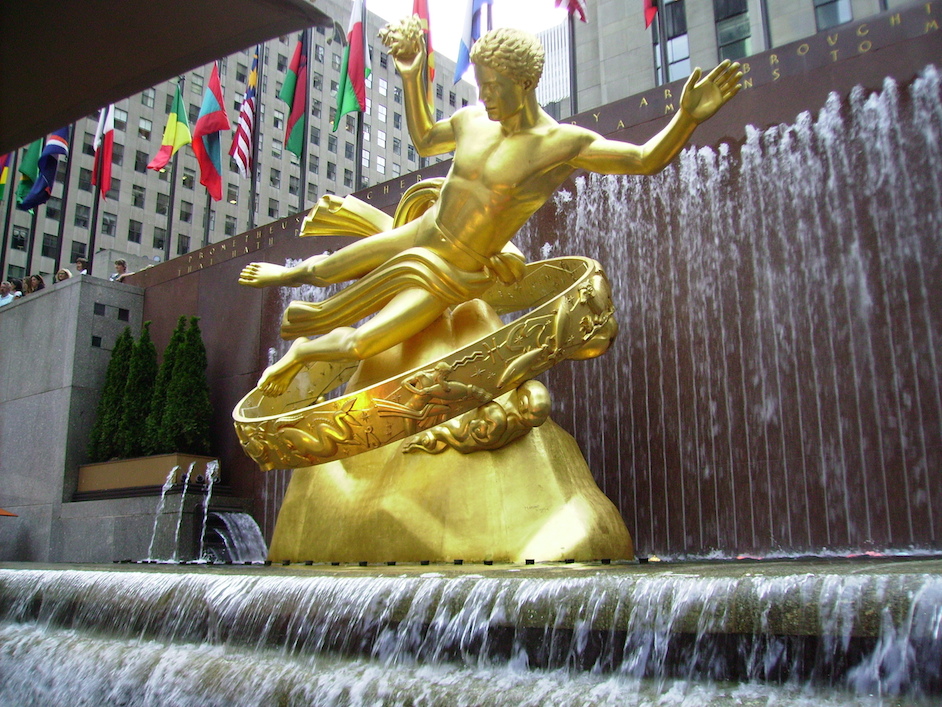
In fall and winter there is no lovelier place to have dinner in New York than behind the glass wall of The Sea Grill at the Rockefeller Center Skating Rink, which after Thanksgiving takes on its Christmas finery and a huge lighted evergreen; come spring and summer there is no lovelier place to be than at that same spot, when the rink becomes a sea of umbrellas shading the tables of people eating there, all under the gaze of a gilded Prometheus.
Not unlike the newly restored Tavern on the Green, The Sea Grill has been enchanting New Yorkers and visitors for decades; in the latter’s case since 1974. At the time of its opening the restaurant served a style of modern American seafood that challenged all the outworn
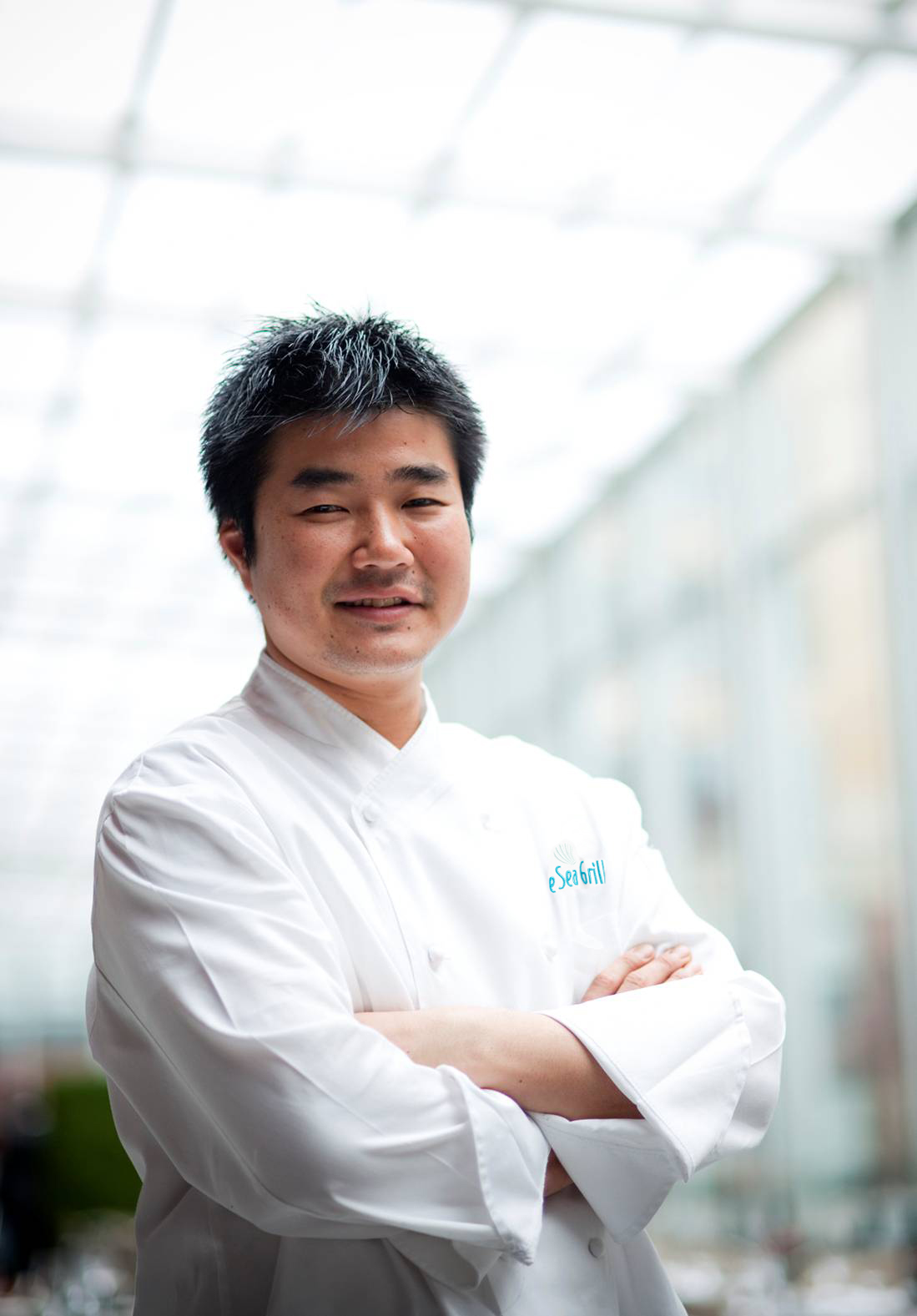 fish restaurants around town to re-think their way of
buying, cooking and preparing fish.
fish restaurants around town to re-think their way of
buying, cooking and preparing fish. As the years wore on, and now under the Patina Group, The Sea Grill only got better, headed for a long tenure by Chef Ed Brown, who gave the menu several signature dishes that other chefs copied, like his Thai red chili mussels, his nonpareil crabcake, and the fabulous chowder.
A new executive chef has come aboard, Japanese-born and Hawaii-raised Yuhi Fujinaga, who has introduced a new Sushi and Sashimi Lounge Menu showcasing a variety of rolls, sashimi, and raw bar options like spicy ahi tuna pressed sushi, Long Island fluke ceviche with passion fruit and mango, and marinated and flash-seared Imperial Wagyu nigiri beef rolls with crispy sushi rice and a Korean barbeque glaze. Fujinaga has also had a hand in choosing the appropriate sakes to go with his food.
The Sea Grill’s admirable wine list has always tilted towards global whites, with bottlings in every price category.
Seafood is brought in daily from Montauk, Long Island, for which Fujinaga has created a special Montauk Seashore Menu, and currently through July 13, the restaurant is featuring an outdoor World Cup Dinner with the games shown on a huge TV screen.
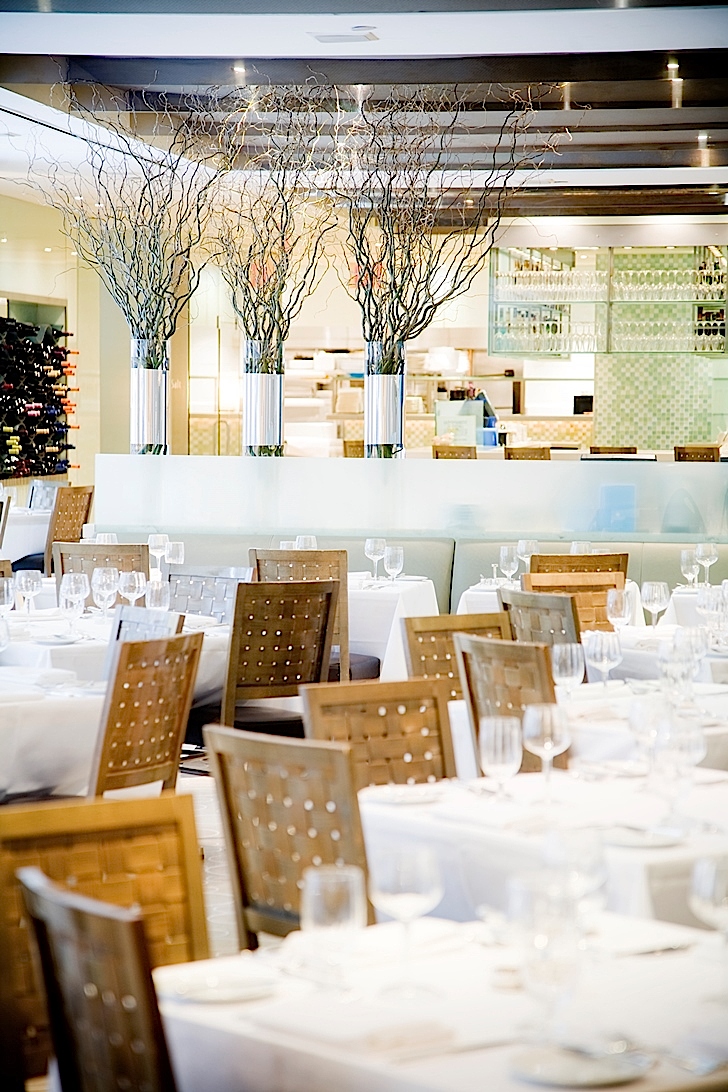 For years I took my
family to The Sea Grill and ice skating at Christmas time. Now, on a recent
summer’s evening, with the great art déco buildings changing color as twilight
came on and the international flags ringing the rink fluttering in a light
breeze, there was nowhere I would rather have been than at The Sea
Grill, with its own cool marine colors of sand and aqua blues.
For years I took my
family to The Sea Grill and ice skating at Christmas time. Now, on a recent
summer’s evening, with the great art déco buildings changing color as twilight
came on and the international flags ringing the rink fluttering in a light
breeze, there was nowhere I would rather have been than at The Sea
Grill, with its own cool marine colors of sand and aqua blues. I wanted to taste again some of my favorite dishes, so I chose the chowder, rich and creamy with lobster, shrimp and clams, with small bits of potato and assertive nubbins of smoky bacon. The soft shells crabs, now in peak season, were big and fat, crusted with herbs and served with grilled hearts of palm, sweet avocado puree, and guinilla pepper relish, the whole a quartet of wonderful textures, sweet and salty flavors.
The Sea Grill roll of spicy tuna with avocado and aïoli was nothing to get over excited about, and while I loved the idea of abundant lobster, poached in butter with peas, carrots and onions, the flakiness of its lidded crust wilted quickly.
A lavish array of sushi (right)--seven pieces and a sushi roll of Fujinaga’s selection--
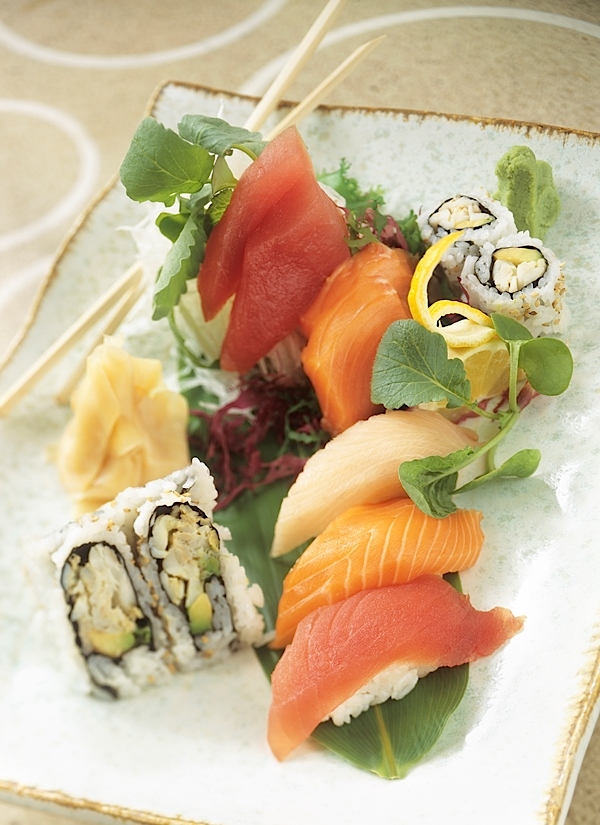 revealed yet again why pristine raw
fish can make me want
to cancel everything else and just keep eating sushi
and sushi and more
sushi. But then I would have missed the
excellent Casco Bay cod cooked à la plancha, with an onion puree,
tiny carrots, sugar snap peas and a wasabi herb oil that made
everything just that more tantalizing.
revealed yet again why pristine raw
fish can make me want
to cancel everything else and just keep eating sushi
and sushi and more
sushi. But then I would have missed the
excellent Casco Bay cod cooked à la plancha, with an onion puree,
tiny carrots, sugar snap peas and a wasabi herb oil that made
everything just that more tantalizing. I could hardly miss The Sea Grill’s famous crabcakes (below), served with a tangy stone ground mustard sauce and pea sprouts, and they lived up to every memory and expectation of them--very meaty, all lump crab, and, outside of sashimi, as pure a dish as might be wished for. Also very good was a beautifully cooked skate simply grilled, with wilted spinach and a cilantro-tomatillo pesto. And don’t miss the hefty side of lobster macaroni and cheese, a dish fit for a princely child or nostalgic adult.
Pastry chef Michael Gabriel crafts his desserts along traditional lines, but packs them full of more flavors and complexities than might be expected in an item like his frozen strawberry parfait, cream gelato, and a delightfully tangy rhubarb consommé. His milk chocolate caramel mousse absorbed the scent of cardamom-poached apricots, with a delicate puff of orange blossom meringue; sumptuous and refined were the caramelized figs, hazelnut cream, and raspberry-red wine sorbet.
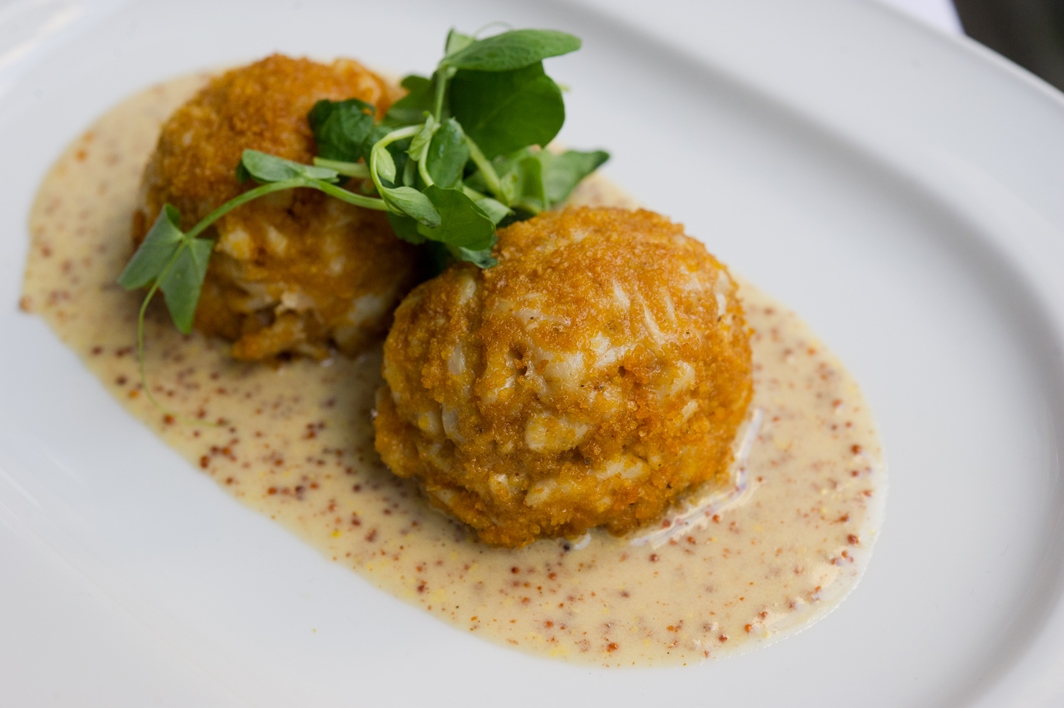 But my
overall favorite--which
is often the case with steamed puddings--is
Gabriel’s chocolate
rendition with the unexpected bitter edge of an
Angostura bitters glaze
and fresh cream; a brilliant idea.
But my
overall favorite--which
is often the case with steamed puddings--is
Gabriel’s chocolate
rendition with the unexpected bitter edge of an
Angostura bitters glaze
and fresh cream; a brilliant idea.And so, as blue sky evening turned into a New York night and the lights came on in the tall buildings around us and the loud sounds of the city began to fade, I sat looking out those huge windows at Prometheus and the elegant shafts of limestone, and realized that wherever I’ve dined in the world there have been restaurants that imbue and partake of a city’s spirit--OXO Tower in London, Jules Verne in the Eiffel Tower in Paris, the Hassler Hotel overlooking the Spanish Steps in Rome. In New York, The Sea Grill imbues the city with as much vitality as the city itself returns.
Photo by Daniel Krieger
The Sea Grill is open for lunch Mon.-Fri. and for dinner Mon.-Sat. Dinner appetizers run
$15-$21, main courses $34-$42. Three-course menu at $55.
❖❖❖
By John Mariani
WHAT I’M DRINKING THIS SUMMER
"Luncheon on the Grass" by Manet
With the possible exception
of Port after dinner, I shun no wines in summer
just because it’s a tad hot outside. True,
there are wines like cold rosés and whites
that may hold up better (for the first few
minutes) under the assault of 90-degree weather,
but if I’m grilling steaks or barbecuing, I’m not
going to deny myself the pleasure of the meat +
red wine alliance. I will, however, make sure the
reds are cool—not cold—at about the same
temperature I’d serve them in winter or in an
air-conditioned room, about 55 to 60 degrees.
That said, here are some of the
wines I’ve been enjoying this summer.
Bella Maple Vineyards Dry Creek
Valley Zinfandel 2010 ($38)—This limited edition (only
530 cases) flagship
zin, made by husband-wife team Scott and
Lynn Adams and winemaker Mike Dashe is based on
vines that date back to 1915, and breeding shows.
This is a very soft zin with a better balance than
most out of California, with appropriately dark
fruit and loosened tannins, along with a
reasonable 14.8 percent alcohol.
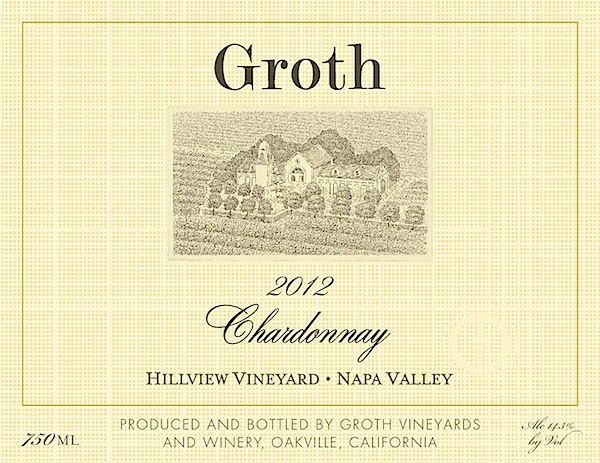 Dutton Ranch Russian River Valley
Pinot Noir 2010 ($39)—California’s Dutton Ranch
gets its grapes from 66 different vineyards, so,
as in Burgundy, their pinot noirs are blends that
aim at a balance of soft tannins, fruit and acids. At 14.2
percent alcohol, it’s not one of those Russian
River Valley blockbusters and instead has far more
finesse than most.
Dutton Ranch Russian River Valley
Pinot Noir 2010 ($39)—California’s Dutton Ranch
gets its grapes from 66 different vineyards, so,
as in Burgundy, their pinot noirs are blends that
aim at a balance of soft tannins, fruit and acids. At 14.2
percent alcohol, it’s not one of those Russian
River Valley blockbusters and instead has far more
finesse than most.
Groth Hillview Vineyard Napa
Valley Chardonnay 2012 ($29)—Better known for their
cabernet sauvignons since 1981, Dennis and Judy
Groth (he was a key architect that built Atari)
also produce this fine chardonnay, via winemaker
Michael Weis, from one of the best vintages of the
decade. The wine spent eight months in French oak
barrels, was racked from the lees and finished for
bottling. Although
the aroma takes some time to develop in the glass,
this is a clean Chablis-like chardonnay, brisk and
easy to drink with any seafood. It has
none of that cloying caramel of so many California
examples.
Inama Carménère
Pui 2010 ($15-$19)—Carménère
is not a widely recognized varietal outside of
Chile, but this example from Italy’s Veneto region
is impressive, with a gorgeous aroma that blows
from the glass and a velvety texture that is ideal
for summer meats, not least hamburgers.
Counterpoint Laurel Glen
Cabernet Sauvignon 2012 ($35)—A Sonoma Valley cabernet
sauvignon at a good price and admirable alcohol
level of just 14.4 percent. The
nose reveals little but it has lush,
ripe fruit, almost more like a merlot than a cab. The
winery’s website says 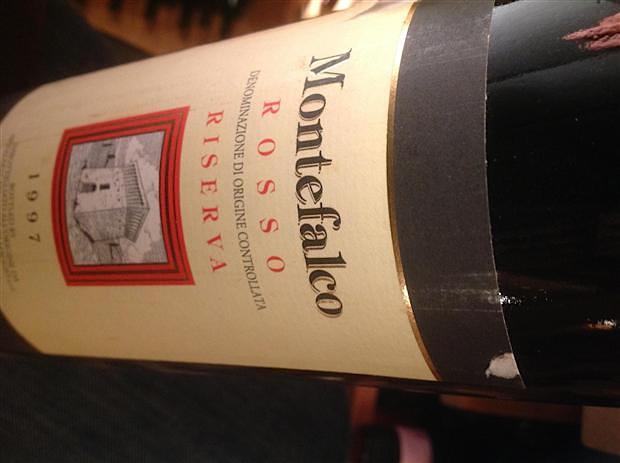 this is
“meant to be enjoyed upon release,” so drink it up
this summer with lamb chops or chicken on the
grill.
this is
“meant to be enjoyed upon release,” so drink it up
this summer with lamb chops or chicken on the
grill.
Arnaldo Caprai Montefalco
Riserva Rosso 2009 ($23)—A terrific price for a
very full-bodied wine from the Italian region of
Montefalco, Umbria, intended for everyday
drinking. Made
from 70 percent sangiovese, 15 percent sagrantino
and 15 percent merlot, it has a lovely nose,
forward fruits and tannins still taut enough to
give it a backbone.
With pork or barbecued meats this is a real
winner. The winery also makes a fine Reserva and a
white white from the unusual grachetto grape; it’s
very full bodied without any wood aging and at $19
is a good buy.

Vinkara Narince Reserve Kalecik Ankara 2010
($18-$25)—I had two surprises while tasting this
wine: first, it is from Turkey, specifically
Ankara, from
a winery only begun in 2003, now with 420 acres of
vineyards and a capacity of more than 1 million
liters. Second,
it is a five year-old white wine that has really
held up, owing to its acid structure that
preserves the clean, bracing flavors of the
Narince grape, whose name means “delicately” in
Turkish. Perfect
with shellfish and seasoned sauces.
Domaine de Nizas Rosé 2013
($17)—Far too many rosé wines are at best
predictable and too often bland and watery. This
rosé, from the Languedoc, has a hefty 14
percent alcohol—high for a rosé—a good
color, and well-rounded, complex levels of flower
and fruit flavors with a little anise in the
background.
A delightful wine just to sip as an
aperitif or with cold foods and salads.
❖❖❖
AN AMORE FOR ABRUZZO

by Cristina Mariani-May
co-CEO of Banfi
Vintners America's leading wine
importer
Abruzzo
is one of Italy’s unsung regions in terms of its raw
beauty, history, and winemaking. The Cerulli
family has been part of the regional fabric of
Abruzzo for centuries. Like others in the area they
prospered not as much from olives and grapes as from
prized wool sheared from local sheep and delivered
to Florence where it was woven into world-renowned
textiles. The family was always forward-thinking,
and in the 1960s were one of the founding families
behind Casal Thaulero which, under Cerulli
presidency, swiftly went on to become Abruzzo’s most
successful wine cooperative.
More recently, the current
generation, led by Enrico Cerulli (below), has
taken over management of the family’s ancestral
property, Azienda Agricola Cerulli Spinozzi, a
148-acre estate now planted mostly to vineyards of
Montepulciano. Long synonymous with Abruzzo, the
Montepulciano grape is widely known as a reliable
and generous if often predictable red wine what is
sometimes confused with a town of the same name in
Tuscany where Sangiovese-based wines are produced.
Enrico’s passion is to make
outstanding wine in this immeasurably superior
quality subzone called Colline Teramane (Teramane
Hills), Abuzzo’s only DOCG (awarded in 2002),
accounting for less than .5% of the volume of the
larger DOC.
Here, late-ripening Montepulciano
thrives on the south/southeast facing slopes, in the
shadow of Europe’s southernmost glacier and Italy’s
highest summit – the Gran Sasso. Extra hang
time enables grapes to develop lush cherry,
blackberry and black currant notes. Nightly
temperatures drop dramatically, by as much as 20°
F, enhancing aromatics and structure. The
result is a wine in a totally different class
from the everyday quaffing Montepulciano from the
lowlands. Deep
colored and long lived, redolent with complex fruit
notes, this wine is a perfect example of the
oft-quoted “iron fist in a velvet glove.”
Cerulli
farms organically, controlling pests with eco-friendly
copper salts and giving leaves plenty of air space.
For his top bottling, the single vineyard Torre Migliori,
Enrico keeps a small area of 30-year-old vines for the
complex must they produce, despite the exorbitant cost
of farming these low-yield plants. He hand harvests
his grapes in small boxes and vinifies them in a
custom designed gravity-flow winery (opened in 2003)
to minimize handling.
The wine undergoes a lengthy fermentation on
the skins, and is aged in oak barrels for 16 months
plus at least six more months in bottle before 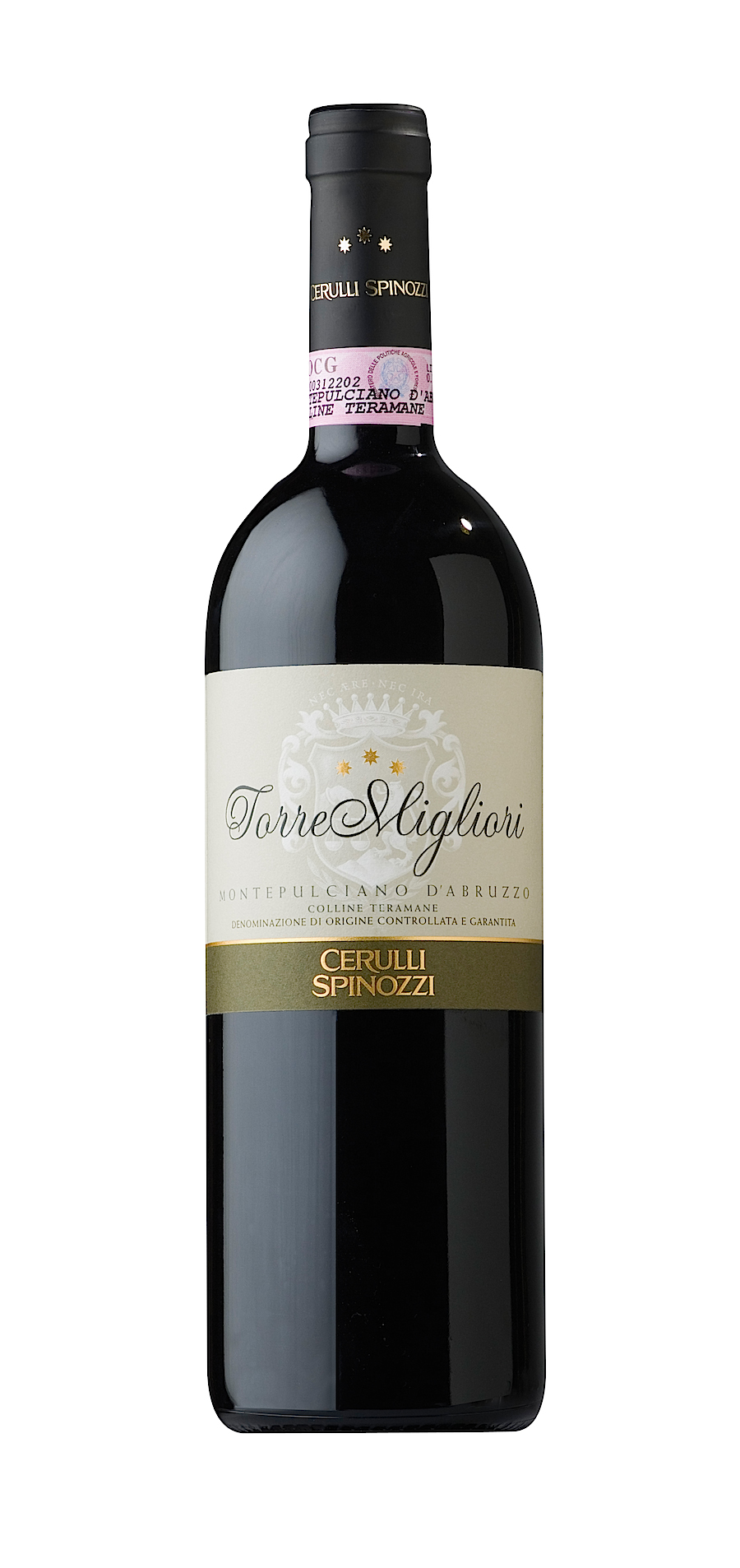 release. It is
intense and complex, with notes of rich ripe cherries,
blackberries, black currants and cloves. This
elegant, well- structured wine is suitable for
moderate aging, and was even selected by the President
of the Italian Republic to toast 44 visiting heads of
state attending the 2009 G8 summit.
release. It is
intense and complex, with notes of rich ripe cherries,
blackberries, black currants and cloves. This
elegant, well- structured wine is suitable for
moderate aging, and was even selected by the President
of the Italian Republic to toast 44 visiting heads of
state attending the 2009 G8 summit.
Enrico also produces a white wine
called Cortalto,
made from another classic varietal of Abruzzo,
Pecorino. They
say the wine takes its name from the sheep (pecore in
Italian) who would snack on the grapes while grazing
in the nearby fields.
The wine is fermented in stainless
steel prior to partial malolactic fermentation, and is
aged on its lees for 5 months prior to bottling. It has
subtle aromas of white flowers, peach and citrus;
vibrant and zesty on the palate, it is classically
Italian in flavor – meaning that it has a great vein
of minerality and acidity that make it a great food
wine, with a hint of bitter almond on the lingering
finish.
The duet of Cortalto and Torre
Migliori is perfectly symbolic of Abruzzo; the
Pecorino goes so well with much of the fresh seafood
typical of the Adriatic coast, and the Montepulciano
is delicious with classic inland mountain dishes like
lamb and roast pork.
The Cerulli family’s commitment to quality has
made this family a standard bearer for the land where
for several months of the year you can ski on the Gran
Sasso in the morning and swim in the warm Adriatic in
the afternoon!
BUT THEN, NEITHER WAS ANTHONY QUINN

A man in Scarsdale NY and another from Queens, NY, have sued Chobani Greek Yogurt because it has Turkish roots and isn't Greek, contending that "None of the products sold in the US are made in Greece or made by Greek nationals" and that consumers are "reasonably confused because they have a reasonable expectation that a Greek yogurt is from Greece--as French wine is from France or Russian caviar is from Russia."
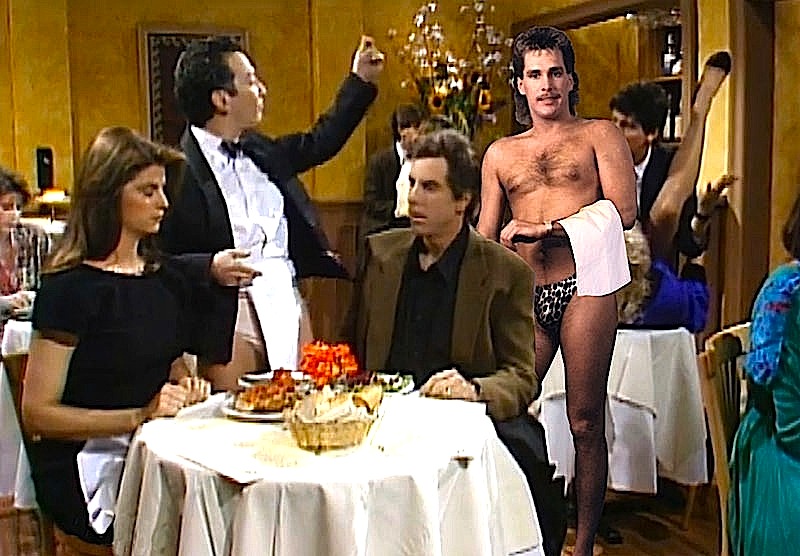 NO
SEX, PLEASE! WE'RE BRITISH!!
NO
SEX, PLEASE! WE'RE BRITISH!!"The waiter comes up to your table and does a spiel of real fast-talking Soprano chat, with the hands, the stance, the everything. He talks up the menu as if every dish is his sister's tits."--AA Gill, "Carbone," (London) Times Sunday Magazine.
Any of John Mariani's
books below may be ordered from amazon.com.
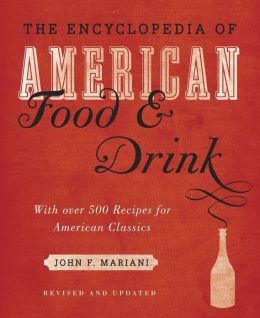 |
The Encyclopedia of American Food and Drink by John F. Mariani (Bloomsbury USA, $35) Modesty forbids me to praise my own new book, but let me proudly say that it is an extensive revision of the 4th edition that appeared more than a decade ago, before locavores, molecular cuisine, modernist cuisine, the Food Network and so much more, now included. Word origins have been completely updated, as have per capita consumption and production stats. Most important, for the first time since publication in the 1980s, the book includes more than 100 biographies of Americans who have changed the way we cook, eat and drink -- from Fannie Farmer and Julia Child to Robert Mondavi and Thomas Keller. "This book is amazing! It has entries for everything from `abalone' to `zwieback,' plus more than 500 recipes for classic American dishes and drinks."--Devra First, The Boston Globe. "Much needed in any kitchen library."--Bon Appetit. |
"Eating Italian will never be the same after reading John Mariani's entertaining and savory gastronomical history of the cuisine of Italy and how it won over appetites worldwide. . . . This book is such a tasteful narrative that it will literally make you hungry for Italian food and arouse your appetite for gastronomical history."--Don Oldenburg, USA Today. "Italian
restaurants--some good, some glitzy--far
outnumber their French rivals. Many of
these establishments are zestfully described
in How Italian Food Conquered the World, an
entertaining and fact-filled chronicle by
food-and-wine correspondent John F.
Mariani."--Aram Bakshian Jr., Wall Street
Journal.
"Equal parts
history, sociology, gastronomy, and just
plain fun, How Italian Food Conquered the
World tells the captivating and delicious
story of the (let's face it) everybody's
favorite cuisine with clarity, verve and
more than one surprise."--Colman Andrews,
editorial director of The Daily
Meal.com. "A fantastic and fascinating
read, covering everything from the influence
of Venice's spice trade to the impact of
Italian immigrants in America and the
evolution of alta cucina. This book will
serve as a terrific resource to anyone
interested in the real story of Italian
food."--Mary Ann Esposito, host of PBS-TV's
Ciao
Italia. "John Mariani has written the
definitive history of how Italians won their
way into our hearts, minds, and
stomachs. It's a story of pleasure over
pomp and taste over technique."--Danny Meyer,
owner of NYC restaurants Union Square
Cafe, The Modern, and Maialino.
|
 |
 |
 |
 |
 |
 |
 |
 |
 Everett Potter's Travel Report:
Everett Potter's Travel Report: 
 Eating Las Vegas
is the new on-line site for Virtual Gourmet
contributor John A. Curtas., who since 1995
has been commenting on the Las Vegas food
scene and reviewing restaurants for Nevada
Public Radio. He is also the
restaurant critic for KLAS TV, Channel 8 in
Las Vegas, and his past reviews can be
accessed at KNPR.org.
Click on the logo below to go directly to
his site.
Eating Las Vegas
is the new on-line site for Virtual Gourmet
contributor John A. Curtas., who since 1995
has been commenting on the Las Vegas food
scene and reviewing restaurants for Nevada
Public Radio. He is also the
restaurant critic for KLAS TV, Channel 8 in
Las Vegas, and his past reviews can be
accessed at KNPR.org.
Click on the logo below to go directly to
his site.

Tennis Resorts Online: A Critical Guide to the World's Best Tennis Resorts and Tennis Camps, published by ROGER COX, who has spent more than two decades writing about tennis travel, including a 17-year stretch for Tennis magazine. He has also written for Arthur Frommer's Budget Travel, New York Magazine, Travel & Leisure, Esquire, Money, USTA Magazine, Men's Journal, and The Robb Report. He has authored two books-The World's Best Tennis Vacations (Stephen Greene Press/Viking Penguin, 1990) and The Best Places to Stay in the Rockies (Houghton Mifflin, 1992 & 1994), and the Melbourne (Australia) chapter to the Wall Street Journal Business Guide to Cities of the Pacific Rim (Fodor's Travel Guides, 1991).


MARIANI'S VIRTUAL GOURMET
NEWSLETTER is published weekly. Editor/Publisher: John
Mariani.
Editor: Walter Bagley. Contributing Writers: Christopher Mariani,
Robert Mariani, John A.
Curtas, Edward Brivio, Mort Hochstein, Suzanne
Wright, and Brian Freedman. Contributing
Photographers: Galina Stepanoff-Dargery,
Bobby Pirillo. Technical Advisor: Gerry McLoughlin.
To un-subscribe from this newsletter,click here.
© copyright John Mariani 2014
